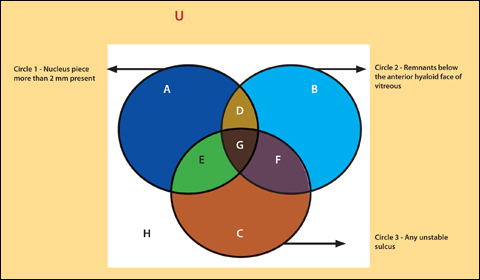Venn diagram charts course for decision making in cases of posterior capsular rupture
The schematic can help surgeons determine the proper course of treatment under different clinical circumstances in the operating room.
Using a Venn diagram in the operating room may help cataract surgeons manage cases of intraoperative posterior capsular rupture, according to a surgeon.
Ashvin Agarwal, MD, designed the diagram as a guide to various clinical scenarios associated with posterior capsular rupture (PCR).
“The problem with charting out a treatment option for iatrogenic PCR is that, when an iatrogenic PCR occurs, it can happen at many steps during the cataract surgery and has different management options when it occurs in these different instances,” Agarwal told Ocular Surgery News. “Hence, pinning a single treatment to this disastrous complication can be erroneous and not in the right light. Having this diagram in our operating room will give us the confidence and the know-how to handle a PCR scenario with a clear distinction as it happens, be it any stage.”

Universal set and subsets
A Venn diagram shows possible logical relationships between distinct finite sets. In Agarwal’s diagram, a universal set (U) represents the overall condition in question, PCR. The universal set comprises eight subsets (A through H) that represent clinical scenarios related to PCR and appropriate treatment options for each scenario.
Circle one represents the presence of nuclear fragments larger than 2 mm. Circle two represents the presence of nuclear or cortical remnants that are posterior to the anterior hyaloid face. Circle three represents an unstable sulcus that precludes lens placement.

Image: Agarwal A
Subsets A through D
Subset A, within circle one, represents nuclear fragments larger than 2 mm. There is no overlap with circles two and three. Thus, the lens and remnants are all above the anterior hyaloid face of the vitreous and the sulcus is present, Agarwal said.
Recommended treatment in such cases is posterior-assisted levitation, anterior vitrectomy, small-incision extraction of nuclear fragments and implantation of the IOL in the sulcus or bag. Another option is posterior-assisted levitation, anterior vitrectomy, IOL scaffold and IOL placement in the bag, Agarwal said.
Subset B, within circle two, represents lens fragments that have fallen below the anterior hyaloid face. There is no overlap with circles one and three. Thus, the nuclear fragment is smaller than 2 mm and can be removed with the vitrector, with the sulcus present. The treatment option in such cases is a three-port pars plana vitrectomy with implantation of the IOL in the sulcus or bag.
Subset C, within circle three, represents an unstable or absent sulcus resulting from a tear in the anterior capsulorrhexis rim or zonular dehiscence. There is no overlap with circles one and two. The lens nucleus is smaller than 2 mm and remnants are above the hyaloid face of the vitreous. The suggested treatment approach is an anterior vitrectomy with implantation of an anterior chamber IOL, scleral-fixated IOL or glued IOL, Agarwal said.
Subset D overlaps circles one and two. In this scenario, the nucleus is larger than 2 mm, with lens remnants posterior to the anterior hyaloid face, mid-vitreous or posterior. The sulcus is intact. Suggested treatment is a three-port pars plana vitrectomy and a fragmatome to emulsify the nucleus, plus implantation of a sulcus-fixated IOL; a three-port pars plana vitrectomy with sleeveless phaco tip-assisted levitation, IOL scaffold and implantation of a sulcus-fixated IOL; or a three-port pars plana vitrectomy with sleeveless phaco tip-assisted levitation, small-incision explantation of the nucleus piece and implantation of a sulcus-fixated IOL.
Subsets E through H
Subset E overlaps circles one and three. The nucleus is larger than 2 mm, lens remnants are not posterior to the anterior hyaloid face, and the sulcus is absent. Treatment involves posterior-assisted levitation, anterior vitrectomy and small-incision explantation, with implantation of an anterior chamber IOL, scleral-fixated IOL or glued IOL; or posterior-assisted levitation and anterior vitrectomy, IOL scaffold and implantation of a scleral-fixated or glued IOL.
Subset F overlaps circles two and three. Thus, there is a lens remnant posterior to the anterior hyaloid and an unstable sulcus with no nucleus or a nucleus smaller than 2 mm. Suggested treatment is a three-port pars plana vitrectomy with implantation of an anterior chamber IOL, scleral-fixated IOL or glued IOL.
Subset G overlaps circles one, two and three. Thus, the nucleus is larger than 2 mm, the remnant is posterior to the anterior hyaloid face and the sulcus is unstable. Treatment involves a three-port pars plana vitrectomy with sleeveless phaco tip-assisted levitation or fragmatome, small-incision explantation and implantation of an anterior chamber IOL, scleral-fixated IOL or glued IOL; or a three-port pars plana vitrectomy with sleeveless phaco tip-assisted levitation or fragmatome, IOL scaffold and implantation of a scleral-fixated or glued IOL.
Subset H is outside all three circles. Thus, there are no nucleus fragments present, and no lens remnants have fallen posterior to the anterior hyaloid face.
This scenario is typical when the PCR occurs after all nuclear and cortical material is removed and there is no disruption of the sulcus, Agarwal said. Treatment depends on the presence of vitreous. If there is no vitreous present, the surgeon should implant an IOL in the sulcus. If vitreous is present, the surgeon should perform an anterior vitrectomy and implant an IOL in the sulcus.
“In all of the above [scenarios], a PCR has to have happened on the table,” Agarwal said. “Also, this diagram will work only if there are no other complications other than PCR, such as retinal detachment or vitreous hemorrhage.” – by Matt Hasson
- For more information:
- Ashvin Agarwal, MD, can be reached at 19 Cathedral Road, Chennai – 600086, India; email: agarwal.ashvin@gmail.com.
Disclosure: Agarwal reports no relevant financial disclosures.
